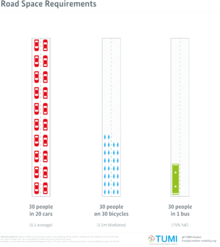
Back مدينة متراصة Arabic Ciutat compacta Catalan Město krátkých vzdáleností Czech Stadt der kurzen Wege German Ciudad compacta Spanish Kompaktikaupunki Finnish Ville compacte French עיר קומפקטית HE コンパクトシティ Japanese 압축 도시 Korean
This article is written like a research paper or scientific journal. (July 2022) |

The compact city or city of short distances is an urban planning and urban design concept, which promotes relatively high residential density with mixed land uses. It is based on an efficient public transport system and has an urban layout which – according to its advocates – encourages walking and cycling, low energy consumption and reduced pollution. A large resident population provides opportunities for social interaction as well as a feeling of safety in numbers and "eyes on the street".[1] It is also arguably a more sustainable urban settlement type than urban sprawl because it is less dependent on the car, requiring less (and cheaper per capita) infrastructure provision (Williams 2000, cited in Dempsey 2010).[2][3][4][5][6]
Achieving a compact city does not just mean increasing urban density per se or across all parts of the city. It means good planning to achieve an overall more compact urban form:
Governments of sprawling cities can take many actions to seek a more compact form, often also involving higher densities. Other cities, such as Cairo, with large, dense slum areas, are responding by reducing urban densities in core areas. In either case, limiting outward urban expansion can be combined with more efficient use of land resources and more effective protection of natural resources. City growth can be physically limited in this way through legislated urban growth boundaries, non-urban green belts, and the quarantining of development in certain areas.[7]
The compact city model, ideally, creates benefits that are attractive to modern urbanites. The desired benefits include shorter commute times, reduced environmental impact of the community, and reduced consumption of fossil fuels and energy. However, research on compact cities from around the globe suggests that these outcomes are not guaranteed. To make matters worse, the design of the cities is limiting residents' access to green space and reasonable views. For the compact city model to gain in popularity, it is necessary to review both their pros and cons.
- ^ The Death and Life of Great American Cities (1961) New York: Random House. ISBN 0-679-60047-7
- ^ Dempsey, Nicola (2010). "Revisiting the Compact City?". Built Environment. 36 (1): 4–8. JSTOR 23289980.
- ^ Bibri, Simon Elias; Krogstie, John; Kärrholm, Mattias (2020). "Compact city planning and development: Emerging practices and strategies for achieving the goals of sustainability". Developments in the Built Environment. 4: 100021. doi:10.1016/j.dibe.2020.100021. hdl:11250/2995024.
- ^ Yao, Yongling; Pan, Haozhi; Cui, Xiaoyu; Wang, Zhen (2022). "Do compact cities have higher efficiencies of agglomeration economies? A dynamic panel model with compactness indicators". Land Use Policy. 115: 106005. doi:10.1016/j.landusepol.2022.106005. S2CID 246425174.
- ^ Kain, Jaan-Henrik; Adelfio, Marco; Stenberg, Jenny; Thuvander, Liane (2022). "Towards a systemic understanding of compact city qualities". Journal of Urban Design. 27 (1): 130–147. doi:10.1080/13574809.2021.1941825.
- ^ Fan, Tianhui; Chapman, Andrew (2022). "Policy Driven Compact Cities: Toward Clarifying the Effect of Compact Cities on Carbon Emissions". Sustainability. 14 (19): 12634. doi:10.3390/su141912634.
- ^ Cite error: The named reference
Routledgewas invoked but never defined (see the help page).